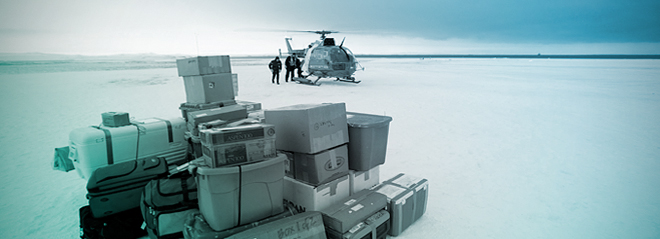To fully understand the impact of climate change and the anthropic pressure on the Arctic ecosystem, the Takuvik program is designed to study both ocean and land ecosystems as well as the interaction between the two components.
|
|

|
|
Ocean ecosystems/geosystems
- Remote sensing of ocean colour and optical properties of the Arctic Ocean;
- Monitoring and ecophysiology of ice-edge phytoplankton blooms in the Arctic Ocean;
- Transcriptomics, taxonomy and diversity of polar phytoplankton species;
- Nitrogen processes and nitrogen utilization by planktonic species in the Arctic Ocean;
- Ecology and population dynamics of zooplankton in the Arctic Ocean.
The overarching goal of the Takuvik ocean research program is to determine the impact of ongoing and predicted environmental change on Arctic Ocean ecosystems and carbon fluxes. Our emphasis will be on biological communities and processes at the bottom of the Arctic food chain because these ultimately fuel all marine animals such as fish, seals, whales, walrus and polar bears. These lowermost trophic levels are also responsible for the most critical biology-related carbon fluxes, and are expected to be the first to respond among living organisms to changes in the Arctic environment. While the primary focus will be marine ecosystems, the research domain will extend from the offshore ocean, to the coast, to aquatic environments of the Arctic Ocean watershed, thence the expected interactions with the land research program presented under the terrestrial ecosystems/geosystems section.
The core objective of this program is to conceive and implement an innovative arctic observing system based on new remote-sensing technologies, and to develop, validate and use diagnostic and predictive ecosystem models to reach the above overarching goal. These models will allow anticipating the impact of climate change and of new human activities on Arctic ecosystems. The tools and improved understanding delivered by this research will help Inuit communities and other northern stakeholders face their enormous challenge of managing and adapting to the rapidly changing Arctic environment. Training the next generation of northern specialists in Arctic ecosystem research, surveillance, management, community consultation and knowledge transfer will also be an integral component of our core objective, and in a global context.
To achieve our core objective, the following specific objectives and related questions will guide the proposed research strategy and key activities. In a way that is analogous to building global and regional climate models based on a deep understanding of the underlying geophysics, the research-based responses to these questions will underpin our formulation of predictive Arctic Ocean ecosystem models:
- To understand the functioning of the arctic marine ecosystems. What is the composition of the microbial communities (biocenoses)? Who are the main players among phytoplankters and bacteria in terms of energy and biomass transfer to higher trophic levels? What are the main ecologically distinct environments (biotopes)? Where do critical biological processes really happen in this environment? What are the interactions between the biocenoses and biotopes? How does the ecosystem work?
- To determine the carbon fluxes (rivers -> coastal environment -> ocean), with special emphasis on those affected by light. What is the impact of bacterial activity and photo-oxidation on mineralizing organic carbon? What is the extent of new organic carbon production by primary production? What are the chemical and physical factors controlling those three carbon fluxes affected by light: primary production, bacterial activity and photo-oxidation? What is the spatial and temporal variability of those three processes? What large-scale physical phenomena control that variability?
- To determine the impact of current and near-future changes in the Arctic environment on marine ecosystems and biogeochemical fluxes. How will CO2 production from the mineralization of old organic carbon be compensated by the new sequestration of carbon? Will the Arctic Ocean experience a major shift biotopes and biocenoses? What will be the impact on higher trophic levels?
- At the methodological level: to achieve a transformative change in the way of observing and monitoring the Arctic Ocean, and in the management, synthesis and application of the resulting data.





